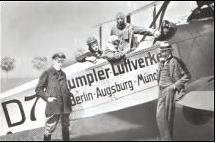| Type |
2 (pilot and observer) |
| Engine |
1 Mercedes D.IVa , 2-bladed fixed-pitch propeller |
| Dimensions |
Length 8,41 m , height 3,25 m , span 12,66 m, wing area 33,5 m2 , |
| Weights |
Empty 1080 kg, loaded 1530 kg , max. take off weight |
| Performance |
Max.. speed 171 km/h a 500 m, cruising speed , range , endurance 3,5 . 4 h , service ceiling 6400 m , climb |
| Type |
Werk.Nr |
Registration |
History |
|
|
D 72 |
Rumpler Werke, DLR/Berlin |
|
|
D-85 |
|
|
4074 |
D-395 |
[LFRA] D-52Luftbildvermessungstrupp der Landesaufnahme/AdlershofTfr LFRB 06.20 |
|
4089 |
D-397 |
[LFRA] D-51Luftbildvermessungstrupp der Landesaufnahme/AdlershofTfr LFRB 06.20 |
| C.IVa |
|
D-32 |
Bayerische Rumplerwerke/Augsburg |
|
|
D-76 |
DLR/Berlin |
|
5741 |
O-BRIS |
Crashed 24 May 1921 at Woluwe-Saint-Lambert, Brussels, operated by SNETA |
The Rumpler C.IV was a German single-engine, two-seat reconnaissance biplane. It was a development of C.III with different tail surfaces and using a Mercedes D.IVa engine in place of the C.III's Benz Bz.IV. The Rumpler 6B 2 was a single-seat floatplane fighter variant with a 120 kW (160 hp) Mercedes D.III engine built for the Kaiserliche Marine (Imperial Navy).
For a two-seater reconnaissance aircraft, Rumpler C.IV had an excellent performance, which enabled it to remain in front-line service until the end of World War I on the Western Front, as well as in Italy and Palestine. Its exceptional ceiling allowed pilots to undertake reconnaissance secure in the knowledge that few allied aircraft could reach it.
300 aircraft were licence-built by Pfalz Flugzeugwerke as the Pfalz C.I, differing in ailerons on all four wings. From February 1917 they were renamed Rumpler C.IV (Pfal).
For use during filming, Slingsby Sailplanes built two Slingsby T.58 Rumpler C.IV replicas. While these were visually similar to the original aircraft, they were structurally completely different, having a steel-tube fuselage structure and wooden wings, and being powered by a de Havilland Gipsy Major engine.



